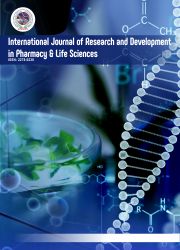ANTIMICROBIAL ACTIVITY OF TABEBUIA ROSEA (FLOWERS)
Keywords:
Antimicrobial effect, S. typhi, E. coli, E. facecalis, B. cereus, C. lunata and C. albicans, flowers of Tabebuia rosea.Abstract
A large number of medicinal plants are claimed to be useful in treating skin diseases in all traditional system of medicine. The present study was carried out to investigate the antimicrobial effect of the sample isolated from the ethylacetate fraction of flowers of Tabebuia rosea. This compound was shown to possess antimicrobial activity against bacteria and fungi, viz. Four bacterial strains were S. typhi, E. coli, E. facecalis, B. cereus and two fungal strains C. lunata and C. albicans by using disc diffusion method. The anti bacterial activity of the compound isolated from ethyl acetate fraction is almost comparable with standard solvent control Chloromphenicol. The anti fungal activity is almost comparable with standard solvent control Fucanazole.
Downloads
References
Srinivasan D, Nathan S, Suresh T, Perumalsamy O. Antimicrobial activity of certain Indian medicinal plants used in folkloric medicine. J. Ethnopharmacol. 2001;74:217-220.
Hamill FA, Apio S, Mubiru NK, Ziraba RB, Mosango M, Maganyi OW, Soejarto DD, Traditional herbal drugs of Southern Uganda, II:literatureanalysisand antimicrobial assays J. Ethnopharmacol. 2003;84:57-78.
Dixon RA (2001) Natural products and plant disease resistance. Nature 411(6839):843-847.
Kinghorn AD (2001) Pharmacognosy in the 21st century*. Journal of Pharmacy and Pharmacology 53(2):135-148.
Wessjohann LA (2000) Synthesis of natural-product based compound libraries. Current Opinion in Chemical Biology 4(3):303-309.
Rojas R, Bustamante B, Bauer J et al. Antimicrobial activity of selected Peruvian medicinal plants. J Ethnopharmacol 88: 199-204, 2003.
Dvorkin-Camiel L, Whelan JS (2008) Tropical american plants in the treatment of infectious diseases. Journal of Dietary Supplements 5(4):349-372.
Olmstead RG, Zjhra ML, Lohmann LG, Grose SO, Eckert AJ (2009) A molecular phylogeny and classification of Bignoniaceae. American Journal of Botany 96(9):1731-1743.
Gentry AH (1992). A Synopsis of Bignoniaceae Ethnobotany and Economic Botany. Annuals of Missouri Botanical Garden, 79(1): 53-64.
Abbott BJ, Hartwell JL, Leiter J, Perdue RE and Schepartz SA (1967). Screening datathe cancer chemotherapy national Service Center screening laboratories. XL, Plant extracts. Cancer Res., 27: 190-345.
Bastein JW (1983). Pharmacopeia of Qollahuaya Andeans, J. Ethnopharmacol., 8: 91-111.
Arenas P (1987). Medicine and magic among the magic the Maka Indians of Paraguayan Chaco, J. Ethnopharmacol., 21: 279-295.
Almedia ER, da Silvia Filho AA, dos Santos ER and Lopes CAC (1990). Antiinflammatory action oflapachol, J. Ethnopharmacol., 29: 239-241.
Perez C, Paul M and Bazerque, An antibiotic assay by the agar well diffusion method, Acta Biologiae et Medicine Experimentalis, 1990, 15, 113-115.
Published
How to Cite
Issue
Section

This work is licensed under a Creative Commons Attribution-NoDerivatives 4.0 International License.







 .
.